How to make an art portfolio: 20 tips to impress
Crafting an art portfolio is more than just compiling your finest pieces into a presentable format. It’s the culmination of your artistic narrative, cohesively assembled to showcase what you’ve achieved and where you’re headed.
Whether you’re a photographer, painter, digital artist, or designer, your art portfolio serves as your ambassador in your creative niche, setting you apart from the competition and speaking on behalf of your unique vision.
Think of it as a tangible reflection of your career highlights and aspirations. More than just a collection point of scanned or photographed works, treat your book with equal parts strategy and soul.
This guide is ready to empower artists like yourself to make an art portfolio book that truly mirrors who you are—personally and professionally—a compelling visual testament to your craft.
What is an art portfolio and its significance?
An art portfolio is a curated collection of your best work as an artist, encapsulating your creative evolution, influences, and expertise. But more than just an accumulation of your work, your art portfolio embodies your skills, style, and creative capabilities.
Picture your art portfolio as a carefully arranged exhibition where each piece contributes to an overarching narrative about who you are as an artist. It can tell the story of your artistic journey and hint at where you’re heading next. It can also emphasize specific styles, techniques, and themes—or be all-encompassing. The story is up to you—and your intended audience.
In the realm of fine arts, portfolios carry immense weight. They’re not merely proof of your technical ability but also showcase your conceptual thinking and personal voice.
Also, curating an art portfolio can be an introspective exercise, helping refine your vision and approach. It enables you to review your progress, understand your artistic inclinations, and plan your creative endeavors.
Your portfolio functions like a passport granting access to opportunities that can define your career, whether applying to art schools, seeking gallery representation, or pitching to clients. A standout portfolio doesn’t just speak volumes; it captivates your audience quietly but powerfully, inviting viewers into a creative world you’ve brought to life.
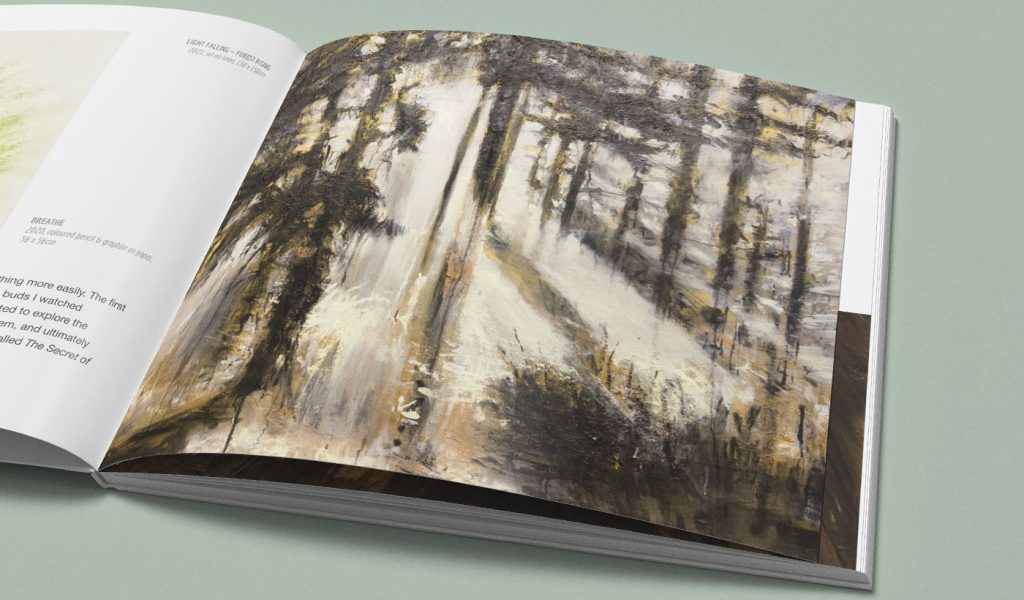
Exploring the different types of art portfolios
Your art portfolio can take many forms, each offering unique advantages. Let’s dive into the three main types: digital, physical, and online portfolios.
Physical art portfolios
A physical portfolio consists of printed photographs and explainer text arranged in a tangible, book-like form. Whether it’s a professionally printed portfolio book or a casual binder of loose prints, the reader’s experience of flipping through physical artwork resonates differently.
Many types of artists (photographers, graphic artists, illustrators, painters, interior designers, and more) and their target audiences (art directors and prospective clients) still revere this traditional method. The advantages of physical art portfolios include:
- Tactile experience: The ability to touch and feel the materials, which offers an authentic sensory experience, creates a stronger connection to your work.
- Focused attention: Free from digital distractions, there can be a greater commitment from the viewer to spend time with your art, offering a better understanding of your capabilities.
- Storytelling: You can tell a story through the layout and presentation of your book to provide viewers with a guided experience of your creations. A strategic layout and presentation can enhance the impact of your art.
- Professionalism and memorability: A physical portfolio demonstrates dedication to craftsmanship, which can leave a lasting impression. Tangibility also provides a more memorable experience compared to digital presentations.
A physical portfolio showcases your art and your commitment to presenting it in the most impactful way. The tactile nature of this format lends an air of professionalism and thoughtfulness that can be pivotal in distinguishing your work within a sea of portfolio websites and digital displays.
Psst. If you’re planning on printing, consider Blurb. It’s a platform specifically for printing visual-heavy books on demand. You’ll find quality, customization, and plenty of educational help (like this blog!).
Digital art portfolios
Imagine having your entire body of work in one sleek device. A digital portfolio is a version of your “book” stored and shared digitally, often as a PDF, slideshow, or other interactive document. A digital art portfolio can supplement a physical format or stand on its own.
It can be as simple as a PDF to easily email prospects or a dedicated USB or storage device to duplicate and distribute. While a digital art portfolio might not offer the same level of engagement as a tangible book, it provides several advantages.
- Increased visibility: Reach a wider audience and attract more opportunities by showcasing work to anyone with internet access, regardless of location or time zone.
- Efficient sharing: Use it when you need quick access to showcase your art at interviews or want to send off submissions swiftly via email.
- Enhanced interactivity: Incorporate interactive elements, such as animations and multimedia, to create a more engaging and dynamic presentation of your work.
- Easy to update: Digital portfolios can be easily updated, allowing you to add new work and projects as quickly as you complete them.
- Cost-effective: It can be a low-cost way to create and share your artwork, eliminating the need for printing and shipping physical materials.
Online art portfolios
An online art portfolio is your personal art gallery, open to the world 24/7. It can take the shape of professional websites, personal blogs, or creative profiles on sites like Behance.net or DeviantArt.com.
Online portfolios enable you to go beyond static images and text. For instance, a beautifully designed website can effectively capture your creative process while further enriching the dimension of storytelling. You can embed videos of art installations, host 3D walkthroughs, provide audio descriptions for more context, and even share behind-the-scenes peeks into your work. Additional advantages include the following.
- Marketing and promotion: Websites can be valuable traffic hubs, whether people are discovering you through search engines or social media sites.
- Elevated interactivity: Beyond photos, interactive elements like videos and animations can enrich viewer engagement.
- Shareability: Online art portfolios broaden your reach potential. Anyone with internet access can admire (and share) your creations.
- Professional image and brand building: Like books, a well-crafted online portfolio presents your work professionally, reflecting your aesthetic and credibility.
- Portability and longevity: Easy accessibility and shareability make them valuable tools whether you’re a student or professional in the art industry.
Each type of art portfolio serves distinct purposes, but they’re not mutually exclusive. Strategically combining them will provide versatility and flexibility in catering to multiple scenarios, helping broaden your reach.
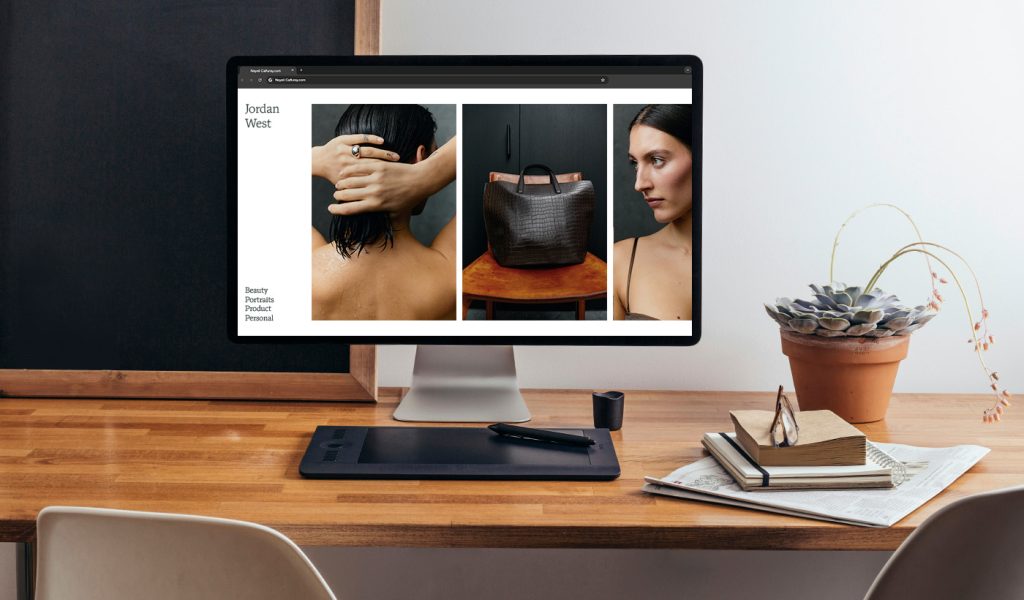
8 steps on how to make an art portfolio
Now for the heart of the portfolio creation process. We’ve assembled these steps to guide you in making an art portfolio that will profoundly impact your audience.
1. Define your portfolio’s audience and objectives
When creating an art portfolio, your first move is to define its viewers and what you hope to accomplish. If you’re reaching out to potential employers or clients, understand their industry standards and preferences. For a college application, research the school’s program focus areas and tailor accordingly. This step determines the type of work to include and how to present it.
Different types of artists might find that certain formats resonate better with their intended viewers. For instance, if you’re a graphic designer, you may benefit from an online portfolio that showcases interactive elements, web design skills, and digital fluency through multimedia presentations or even an animated CV.
On the other hand, if you’re a fine artist aiming for gallery representation, you may opt for a physical portfolio that captures the texture and true color of your pieces. These tangible formats can offer a more authentic experience for curators or collectors who value seeing artwork up close.
In short, defining your target audience and objectives will help shape the format and direction of your portfolio.
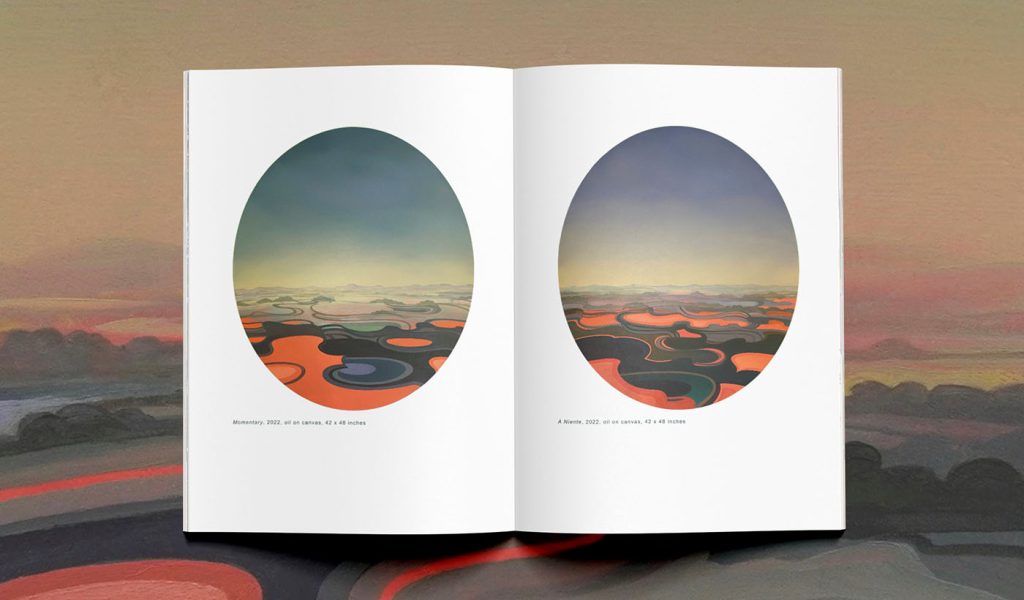
2. Select your best work
In selecting works for your portfolio, quality over quantity is key. Aim for around 15 to 25 pieces unless specified otherwise by provided guidelines. A painter might choose canvases that display technical skill and artistic vision. A graphic artist might highlight a specific perspective or design style.
For example, Jeff Quinn’s Portals is a simple yet stunning representation of his romantic landscape paintings that “capture moments in time where subtle turbulence meets the serene.” Jeff’s portfolio tells his unique narrative while presenting the originality of his work in an engaging portfolio book format.
To craft a standout portfolio, distill your artwork into a curated selection that demonstrates both versatility and mastery:
- Make every piece count: Select pieces with intent and purpose. Each should reveal a facet of your mastery and personal evolution in style. Show the development from initial sketches to polished masterpieces, offering viewers depth beyond surface aesthetics.
- Blend variety and versatility: Demonstrate your range by including various art forms or styles within your craft. The key is to present diversity without diluting quality—each piece should be strong enough to stand on its own while showcasing different facets of your talent.
- Stay consistent in style: Maintains a cohesive thread—a distinctive style or technique—that ties all works together cohesively. Consistency could manifest in color schemes, moods, subject matter, or brushwork that stamps each piece as recognizably yours.
- Incorporate thematic cohesion: Connect your work through themes that resonate throughout your portfolio to create a narrative flow from one piece to another. Threading similar themes provides structure and intent to your collection.
- Demonstrate your technical skills: Show off your artistic chops by displaying various works that demonstrate different techniques and mediums. You might want to include polished pieces and process shots to offer glimpses into your creative process from concept to completion.
Quan Wang’s Watercolor Art Collection is the epitome of how an indie artist can showcase their work as a professional. “As an amateur watercolor artist, I don’t have as much visibility to my work as professional artists,” Quan says. “By creating an art collection book, I have a better new approach to showcase my artwork.”
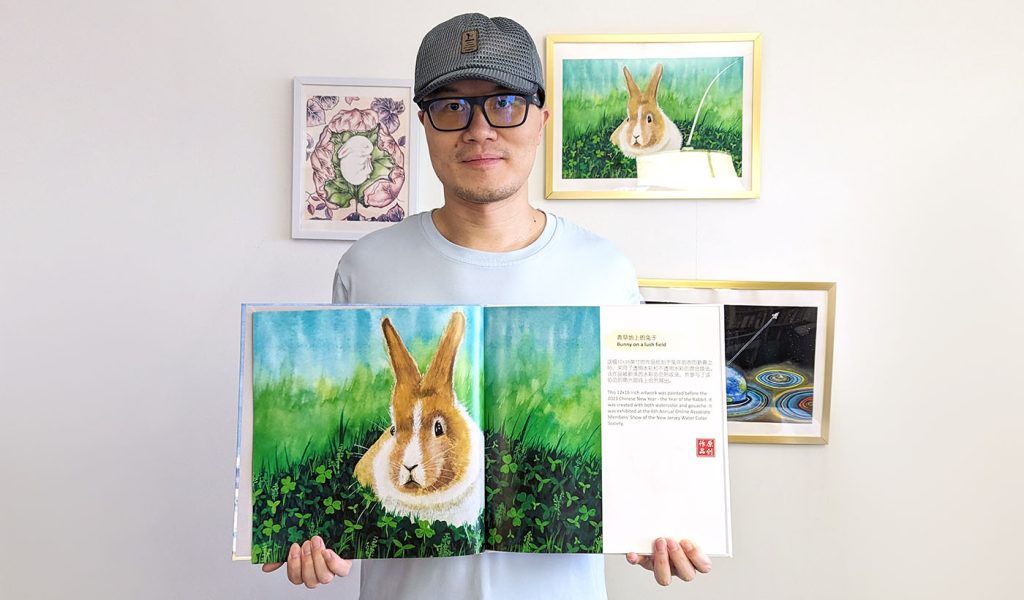
3. Organize thoughtfully
Arrange your work so there’s a logical flow. A narrative that takes viewers on a journey through your growth as an artist can be very compelling. Group pieces with similar themes, techniques, or chronological progression that align visually and conceptually.
The order matters significantly, so begin strong but strategically place standout pieces throughout to maintain interest levels until the end, where you’ll want to finish on a high note.
Choose the right final piece that leaves a lasting impression. It should be one of your strongest works that captures your unique essence as an artist. Think of it as leaving viewers not just satisfied but intrigued, walking away feeling like they’ve had a glimpse into something exceptional but eager to see more.
4. Design with intentionality
From a portfolio design perspective, make sure everything you use—from font selections to color palettes—is intentional. The number one rule with your art portfolio’s
design is to ensure nothing distracts from showcasing your talent. These elements should enhance the overall presentation of your work with clarity and cohesion.
Creating a portfolio that captures the essence of your artistry extends beyond showcasing individual pieces—it’s about designing an accessible, visually cohesive brand experience from start to finish. Here’s how you can achieve this with intentionality.
Use colors and fonts that fit your personality
Colors and fonts are powerful tools in conveying your artistic identity, as they set the tone for how viewers perceive you and your work.
Choose colors wisely, reflecting personal style—whether bold or minimalist—as these visual cues influence mood and engage emotionally with audiences.
As for fonts, select typefaces that resonate with the nature of your art. Modernist pieces might pair well with clean sans-serif fonts, while traditional artworks could call for more classic serif options.
Optimize for seamless accessibility
With web portfolios, you want to optimize your digital portfolio for all devices and audiences. This means it should look stunning on a desktop and provide an equally impactful user experience on smartphones and tablets. Plus, viewers who are colorblind, visually impaired, or have other disabilities should easily access your portfolio. Considering accessibility from the start means a seamless experience for all users and reflects positively on you as an artist.
Likewise, you shouldn’t overlook the importance of accessibility in physical portfolio books, too. This means selecting a binding that lays flat when open, using high-quality paper that minimizes glare, and considering the weight and texture for easy handling. Considering these factors enhances the overall reader experience and allows your artwork to shine without distractions.
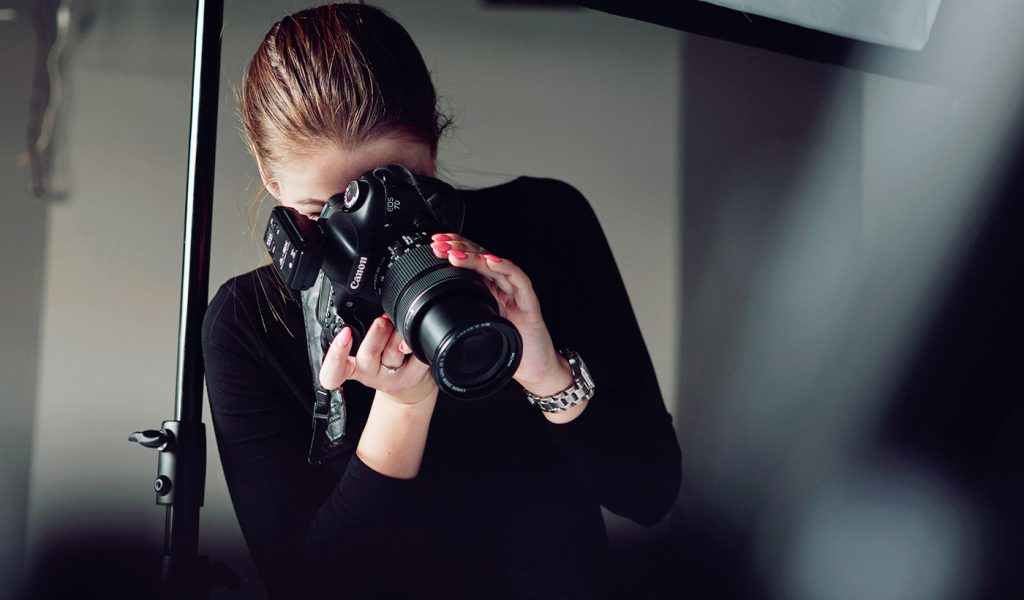
Invest in professional photography
The visual representation of your artwork in the portfolio needs to be as close to reality as possible. Professional-grade photography plays a critical role here.
Use natural lighting or professional setups to avoid glare and ensure true-to-life color reproduction. For 3D works, include multiple angles against distraction-free backgrounds so viewers can fully appreciate their form and texture.
Every aspect of your portfolio’s design should be thoughtfully curated. Together, they form a narrative arc throughout your portfolio pages that speaks volumes about who you are as an artist before your audience views a single piece up close.
Leverage the power of templates
Let’s face it—not everyone is a seasoned book designer, and that’s perfectly okay! This is precisely where the magic of templates comes into play. Using a template is like having an expert by your side, guiding your layout decisions, and ensuring your book has a clear, professional structure from the get-go. It eliminates guesswork and gives you a robust framework to build upon, saving you time and energy to channel back into your art.
When selecting a template, choose one that resonates with your artistic voice and complements the style of your work. Platforms like Blurb offer an array of well-designed templates you can tailor to suit the unique needs of any artist, ensuring your portfolio looks professional and feels authentically you.
No matter what, ensure the template you choose or make has principle design elements on lock.
- Consistency: Employ a consistent layout throughout your portfolio to create a seamless visual narrative. Your audience should flow from page to page without jarring transitions or layout changes that can disrupt the focus on your work.
- White space: It’s not empty space; it’s breathing room for your art. White space directs attention and lets your work stand out, making for a sophisticated and professional presentation.
- Strategic contrast: Highlight your most impactful pieces. Contrasting colors, sizes, and placement can draw the viewer’s eye to your central works while supporting pieces complement your story.
- Incorporate text with purpose: When it comes to including text—be it titles, descriptions, or your artist’s statement—make it count. Keep it minimal and readable, and ensure it supports your visual story without overshadowing your work.
- Alignment: A grid system is your invisible guide that brings order to the page. Align your work to grids to ensure a clean, organized, visually appealing, and professional look.
- Flow: Create a rhythm that guides viewers through your portfolio. Position your artwork in a way that leads the eye naturally from one piece to the next, building curiosity and engagement.
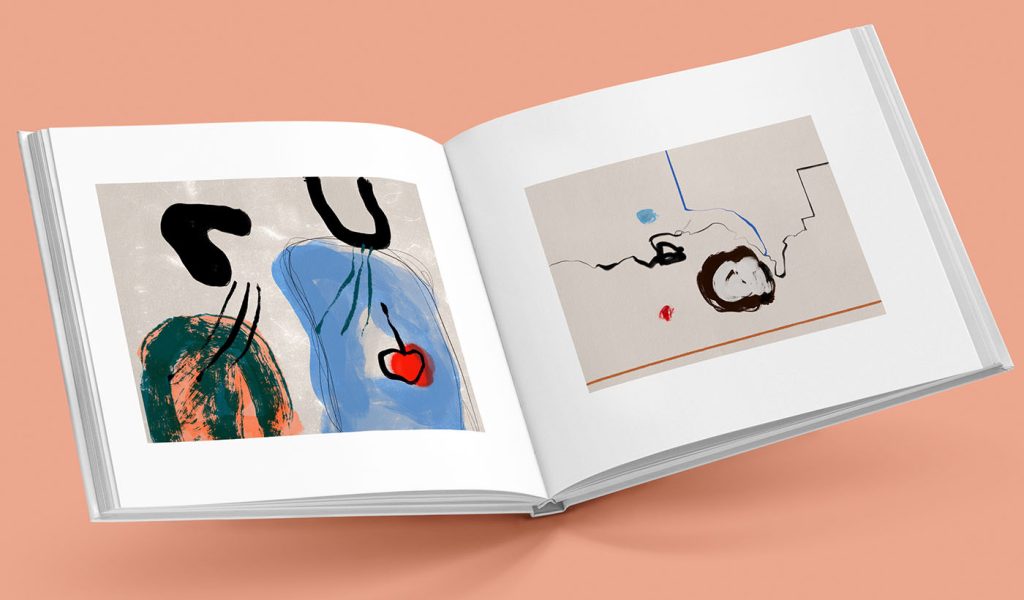
5. Craft a compelling narrative
Be authentic and provide insight into your approach. Share anecdotes or inspirations that led to specific works or techniques. These backstories humanize your portfolio, transforming it from a mere collection of images into a gallery filled with intentionality and purpose.
Tavira ’23 is a powerful example of a portfolio that tells Terry Cripps’ compelling cancer recovery story through a catalog of paintings. Terry adds, “My books are currently a way of publishing to my friends the stuff they never get to see, and paintings they can’t afford. Now they keep the pains and interference of suffering from cancer at bay.”
Developing a compelling narrative within your art portfolio involves weaving together the threads representing you and your artistic journey. Here’s how to integrate copy elements into a cohesive story.
- Contextualize with titles and descriptions: Give each piece context where it’s due by providing titles and brief narratives, offering insight into the inspiration behind the work or its intended message.
- Add an evolving artist’s statement: Keep your artist’s statement updated to mirror current influences in your creative life; it should serve as an open book of who you are now in this moment of artistic pursuit.
- Edit carefully: Typos and grammatical errors can be jarring in an otherwise polished portfolio. Edit your text precisely or, better yet, ask a trusted friend or editor to proofread for you.
- Keep it consistent: If you capitalize the title of your art in one section, capitalize it throughout. If you use an em dash at the beginning, use an em dash (not an en dash) at the end. Consistency is key to a professional presentation.
In addition to these storytelling strategies, you’ll want to ensure you exercise legal diligence by addressing copyright concerns and crediting all sources of inspiration where necessary. For instance, you may need to secure permissions for collaborative works, not just to respect other artist’s contributions but also to uphold ethical standards within the art community.
6. Embrace feedback and critique
Getting an outside perspective on your work is crucial because sometimes we’re too close to our creations to see their flaws—or their strengths! Reach out for feedback from fellow artists or mentors who can offer constructive criticism to polish your portfolio further. This collaborative approach doesn’t just improve individual artworks; it enhances how they fit together as part of one cohesive collection.
7. Be ready to present your work
When the opportunity arises, you’ll want to captivate your audience quickly and effectively. That’s where a well-crafted elevator pitch comes in. It’s a short, engaging summary of who you are as an artist and what sets your work apart. Consider the essence of your style or themes that resonate throughout your portfolio and condense these into a few compelling sentences.
In addition to having a prepared pitch, create thoughtful comments for each piece in your collection. Consider the inspiration behind them, the techniques used, or any challenges overcome during their creation. Being prepared with these insights can make discussions more meaningful and show depth beyond what meets the eye.
8. Make regular updates
An art portfolio should grow with its creator, so regular updates are critical. Aim to add new works every couple of months, as this shows viewers (potential clients, galleries, or schools) that you’re actively creating and evolving as an artist. Updating isn’t just about quantity, though. It’s also about your willingness and ability to improve based on feedback.
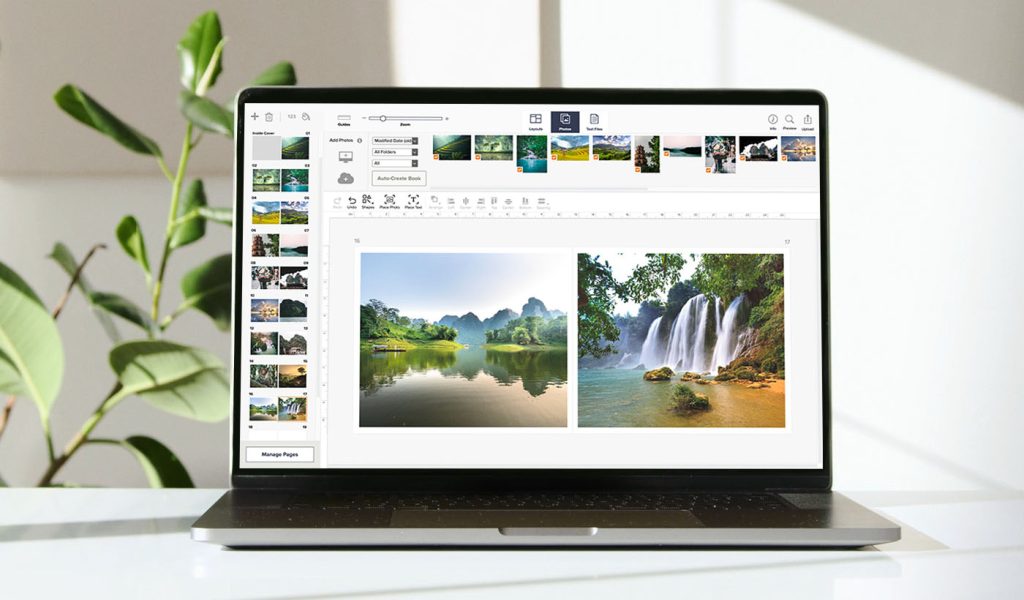
Tools to help you create your art portfolio
When it’s time to showcase your artwork to the world, you’ve got a variety of tools at your fingertips. Each offers unique features tailored to different artistic needs. Here’s a list to help get you started:
- Adobe Photoshop: A powerhouse for photo editing and digital painting, it’s essential for tweaking your images to perfection.
- Adobe InDesign: Great if you’re looking at crafting multi-page layouts—think lookbooks or printed portfolios.
- BookWright: An easy-to-use bookmaking tool to turn your portfolio into a professionally bound book.
- DeviantArt: Long-standing community brimming with diverse artwork—ideal for getting eyes on your creations.
- Format.com: A photography portfolio platform that streamlines the process of creating an online portfolio with easy-to-use layouts.
- Canva: This online design platform adds professional-level utility for a wide range of creative applications, especially sprucing up portfolios with custom graphics.
- Portfoliobox: An online portfolio builder explicitly designed with creatives in mind; no coding skills necessary.
- Pixpa: Boasts all-in-one portfolio websites with client galleries, eCommerce, and blogging capabilities.
- Behance: Perfect for digital artists looking to join a community while displaying their work.
- Squarespace: An intuitive website builder offering sleek templates, ensuring your web portfolio looks as polished as possible.
- ArtStation: It’s a platform and a community hub where concept artists and illustrators thrive.
- Cargo Collective: Catered towards designers and artists seeking minimalist aesthetics in their presentation.
Each platform has its strengths, as some provide robust communities where feedback flows freely, and others might prioritize design flexibility or ease of use above all else. Your chosen toolkit should align with how much control you want over the look and feel of your portfolio and whether being part of an artist network is important to you.
Final words
In the journey of self-expression and professional growth, curating your art portfolio is more than a task; it’s an ongoing celebration of your evolving talents. From highlighting your unique artistic voice and sharing your inspirations to polishing every pixel and keeping fresh works on display—it’s about showcasing who you are and what you can accomplish.
And remember that a well-crafted art portfolio opens doors. Be authentic, edit with precision, and embrace the ever-valuable feedback.
So why wait? Start now and step into the spotlight with a portfolio that’s as vibrant and significant as your art. Create something extraordinary—your future is a blank canvas, and it’s time to make your mark.
***
Build a professional art portfolio with Blurb’s comprehensive toolkit and printing services. Use integrated plug-ins for Adobe InDesign and Photoshop, or create your portfolio using BookWright, Blurb’s intuitive bookmaking software. Share something tangible and leverage the impact of a professionally printed portfolio to showcase your art. Sign up to get started.


This post doesn't have any comment. Be the first one!